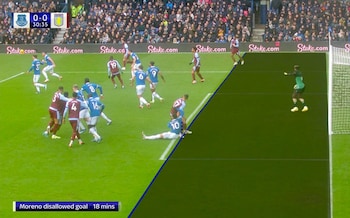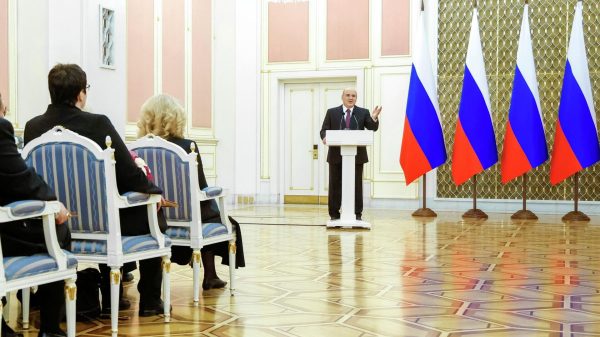 Scenes like these have become all too familiar in recent years. Photo: Charlotte Wilson/Getty Images
Scenes like these have become all too familiar in recent years. Photo: Charlotte Wilson/Getty Images
Now and again, all too rarely, you have the feeling that your life is slipping away in real time. This usually happens during the second hour of frantic doomscrolling, when you realize that you're consuming everything new on your preferred social networks and have nothing to show for it but a ringing, empty feeling. A similar effect can be achieved with prolonged exposure to VAR discourse.
Six years of outrage since the system was first trialled in the 2017/18 FA Cup. We lurch between re-challenging individual decisions, sometimes asking for consistency and sometimes common sense, and the occasional existential scream that greets moments like Coventry's disallowed goal in the FA Cup semi-final. Nottingham Forest flouted protocol and decorum last weekend, implying that the Premier League's strings were being pulled by the malign influence of Big Luton. We were promised a future without disagreements over refereeing decisions; the present only added to the situation.
Forget about the laws and think about the system. It relies on cameras running at 50 or 60 frames per second, which may not be fast enough for Premier League passes and players. In 2019, the Mail on Sunday calculated that frame rate limits could mean an offside error for the fastest 38.8cm players. It's not a legendary toenail or armpit, it's a size 20 shoe.
< p>A 2022 study by Dr Pui Soltani from the University of Bath found that participants invited to evaluate VAR shots had balls kicked 132 milliseconds later than they actually were. “While this delay seems minor, at high speeds this delay can cause significant player displacement,” he says. “In fast-paced sports, where athletes move even faster, this bias increases, resulting in a larger margin of error.”
 Even offside decisions are controversial. Photo: Sky Sports
Even offside decisions are controversial. Photo: Sky Sports
To eliminate such problems, you will need high-speed cameras that can capture events too quickly for the human eye to perceive, but the cost of both the cameras and storage space will be prohibitive. Offside should be an objective truth, and most of the time it seems obvious in person. Things get even murkier when you zoom in on fast-moving athletes: the image becomes pixelated and the lines drawn onto the field by error-prone human hands appear slightly misaligned.
Sometimes it seems that in areas outside of sports, our faith in technology exceeds its competence. Think of the anger when your Pret app stops serving as a clear route to flat white places, your smart freeway shoulder suddenly becomes a traffic lane, or your self-driving car hits your beloved pet. The depth of anger over VAR fits this pattern.
From 2021/22 the restrictions have been recognized and a 5cm margin of error introduced. This effectively creates a 'benefit of the doubt' area where if the two lines we see on the pitch during a VAR offside investigation touch, the line turns green and it is deemed that she is in the game. This green line will disappear next season when we welcome semi-automatic offside.
This will use skeletal tracking systems to track around 30 joints on each player's body. The system will provide a graphical representation of decisions and increase confidence in the exact points of contact with the ball. But we can also expect a resurgence of complaints about minor indiscretions that appear to have been ruled out by the algorithm. Buy shares of Little Britain «the computer says no» GIFs.
Even then, the system may not be flawless. «Some peer-reviewed studies generally report positive results, but suspicions remain due to apparent inconsistencies between the video sequence and bone overlay, especially when played back frame-by-frame,» says Dr. Soltani.
“The AI also tries to pinpoint the location of the skeleton, which is critical to creating clear animations. However, if the imaginary length of the bones is even slightly inaccurate, the animation can go awry, causing arms to cross and ankles to bend as if they were broken. Although accurate, the AI understands appearance rather than functional mechanics. For example, it cannot recognize that an ankle cannot be turned over, but simply guesses where the ankle-like pixels should be.»
 VAR is not universally popular among football fans. Photo: Mark Atkins/Getty Images
VAR is not universally popular among football fans. Photo: Mark Atkins/Getty Images
In theory, the new system will bring us closer to 100 percent accuracy, but is that what proponents really want? Ironically, many fans, journalists and even coaches now prefer to engage in football away from the top flight and the emotion-sapping extra layer of VAR.
Semi-automatic offside sounds like another supposed improvement that will only fuel the debate further. Absolutists of the «Letter of the Law» versus traditionalists of «false Zen». One side shouted «but it's offside», the other unconvincingly stated that they would make bad decisions against their clubs and the lack of VAR. Forever. If this sounds bad, imagine the worst outcome imaginable.
Taken to the theoretical extreme, what if there was an obvious flaw in the technology used to make VAR decisions? Years of paranoid conspiracies are justified, decades of lawsuits follow, and all fairness of competition is destroyed. We may be dealing with a semi-automated Horizon scandal.
The PR battle is lost, but perhaps there is still a solution to preserve the benefits of VAR? I have yet to hear a convincing argument against the method that works in cricket, the NFL and tennis: giving managers a limited number of appeals that they can use at their discretion. If you're wrong, you lose appeal; if you're right, you don't.
However, this solution falls into VAR's fatal cognitive trap: it will be unanimously popular if we just come up with the right settings. We now have plenty of evidence that the only correct solution is to travel back in time and decide that goal line sensors are sufficient for football.






















































Свежие комментарии